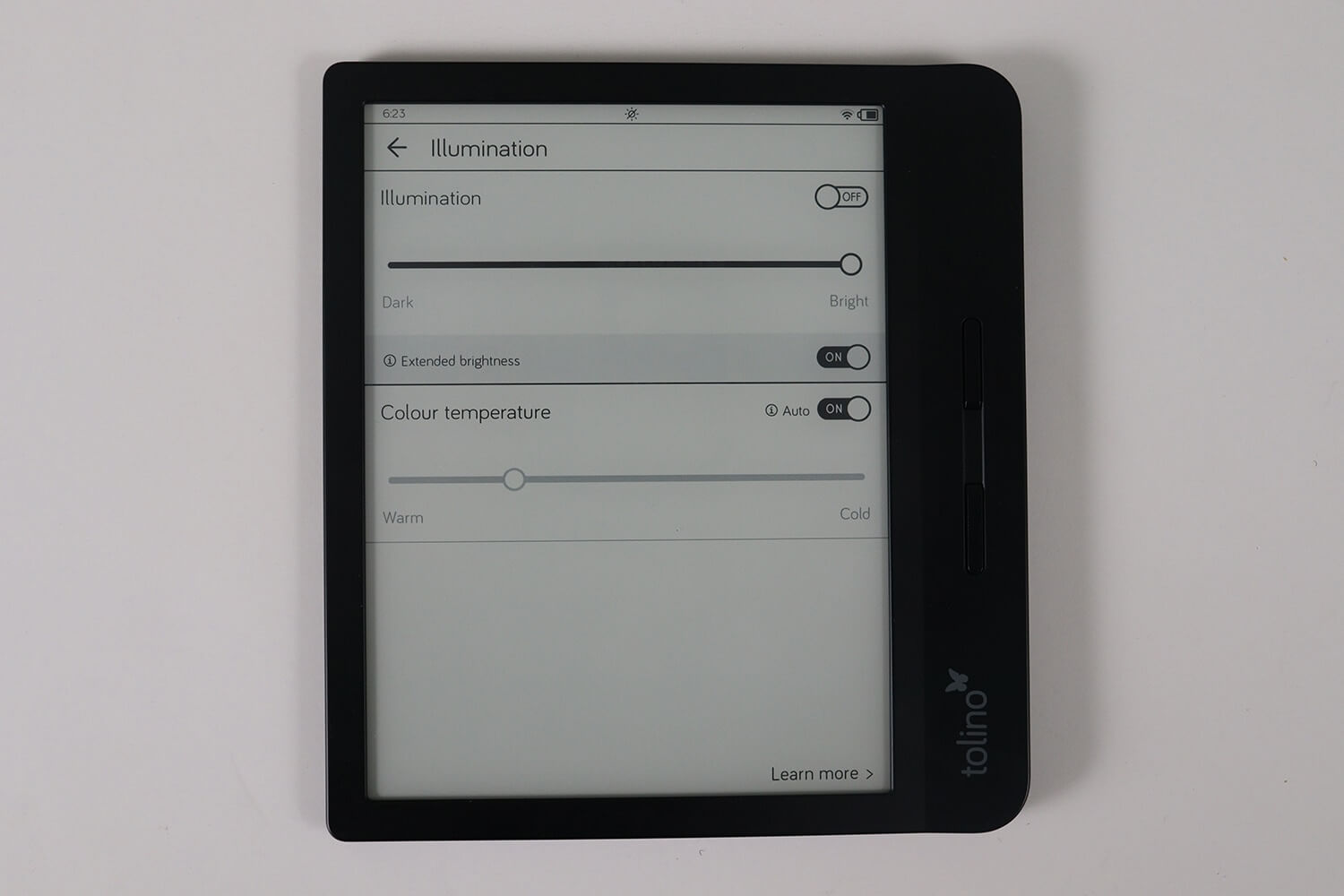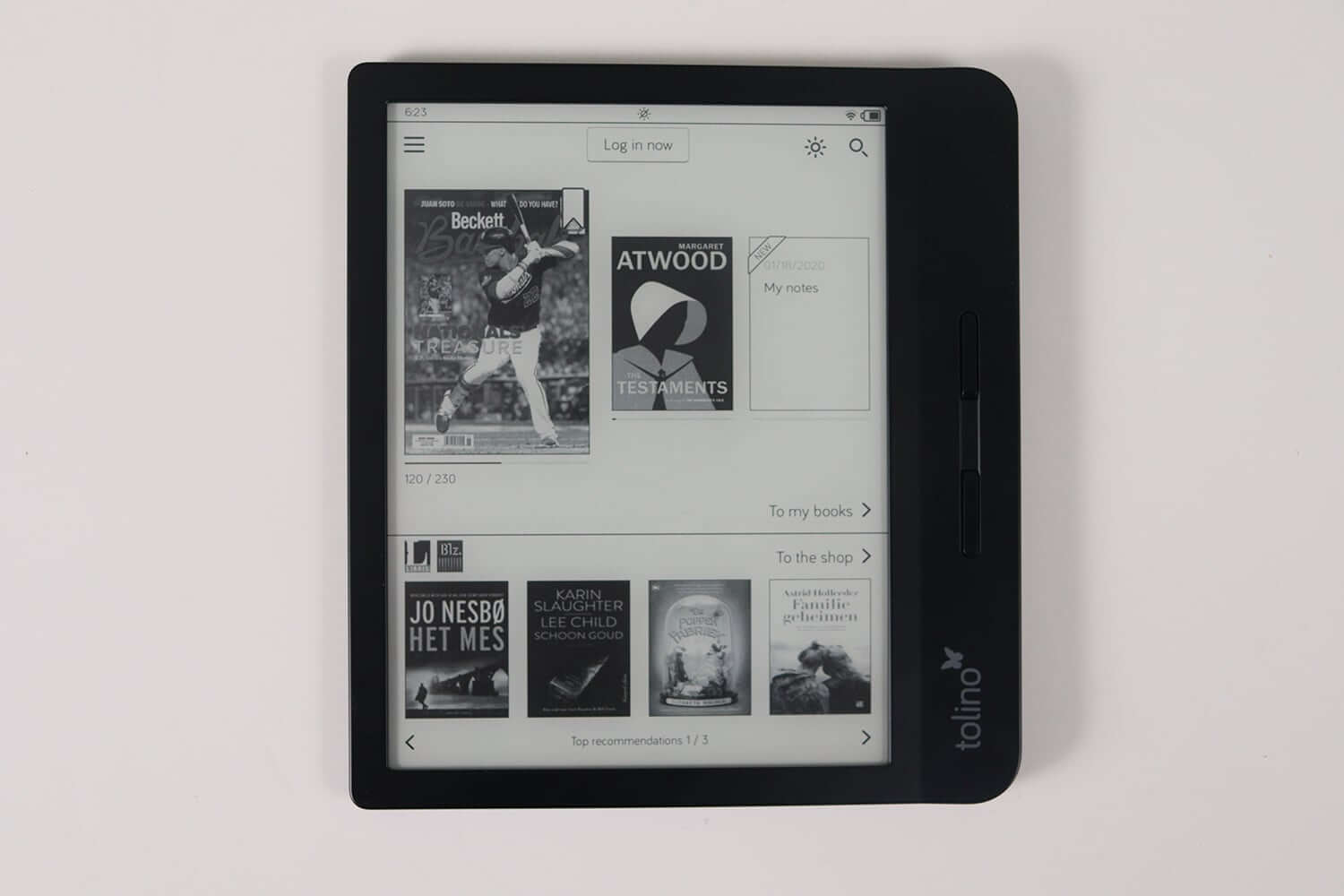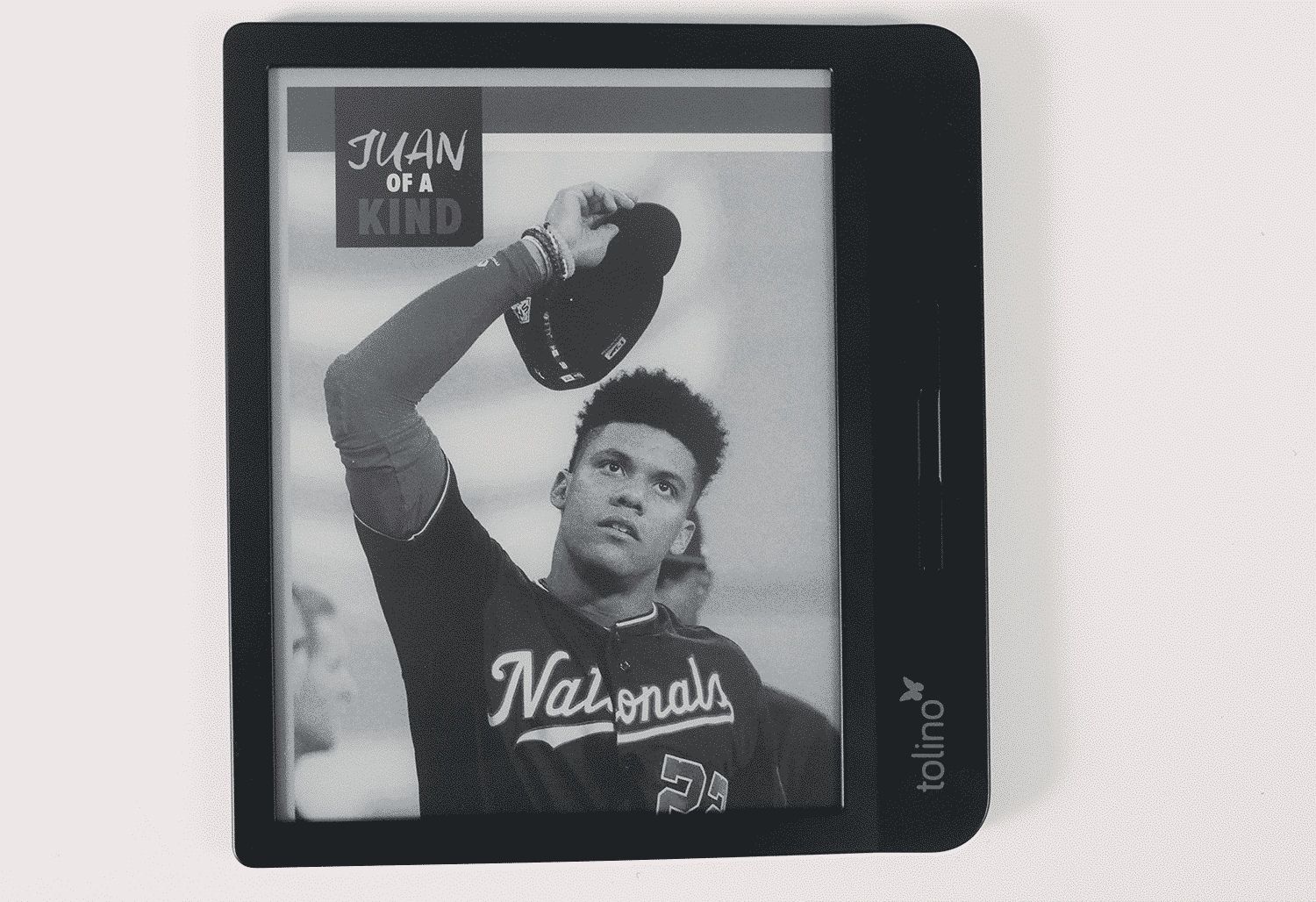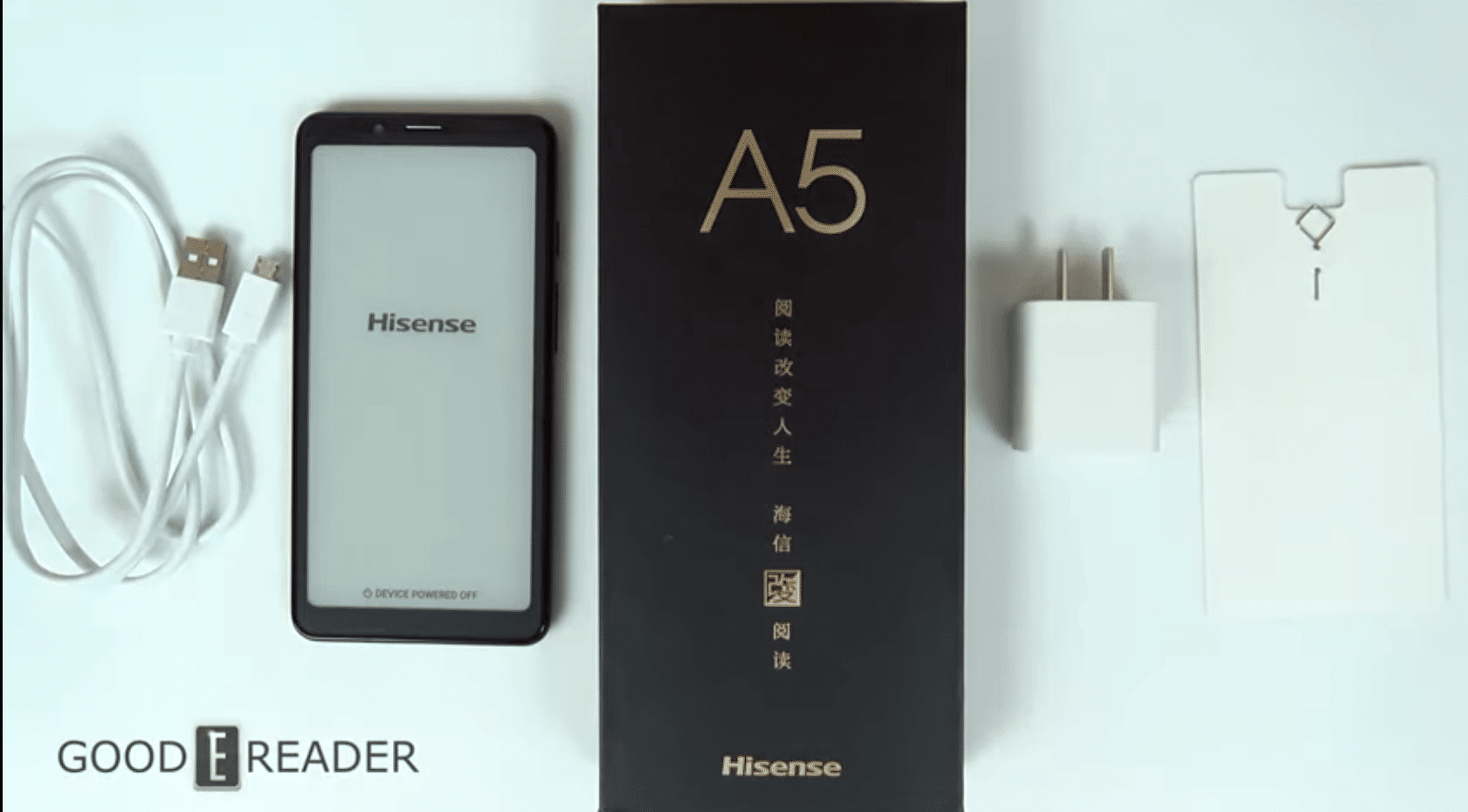
The Tolino Vision 5 is considered a mid range e-reader, and the design sensibility is the exact same as the Kobo Libra H2O. The only difference is the software, which is distinctively Tolino. This hands on review checks out the hardware, shopping ecosystem and ebook experience.
Hardware

The Tolino Vision 5 features a 7 inch E Ink Carta HD display with a resolution of 1,680 x 1,264 and 300 PPI. The screen is not flush with the bezel, instead it has a small recess. It has two physical page turn buttons on the right side of the screen. These buttons be reversed via software, so it is ideal for manga. The screen is capacitive multitouch, so you can also turn the pages by swipes or gestures.

Kobo has incorporated a front-lit screen and their patented Comfortlight screen technology in all of their modern e-readers, and this includes the rebranded Tolino models. The Vision 5 are employing white and amber LED lights on the bottom of the screen and they project light upwards and evenly across the screen. This is great for long reading sessions, because the light is not shining into your eyes. The white and amber LED lights can be used at the same time, with a slider bar in the drop down menu. They can also be used independently of each other, or shut off completely. It also has an auto mode to adjust the light automatically, although this device does not have a ambient light sensor, it instead uses whatever timezone you are in. The lightning system is primarily used in low light conditions and they are better than using the a nearby lamp or a reading light, since the e-reader lights do not normally interfere with your circadian rhythms.
Underneath the hood is a Freescale Solo Lite 1GHZ processor, 8GB of internal storage and 512 MB of RAM. The internal storage stems from an SD card that is only evident if you take the e-reader apart. The SD card is soldered right onto the motherboard and cannot be expanded. The Vision 5 is powered by a 1,200 mAh battery that should provide two weeks of constant reading on a single charge. If you are a casual reader, maybe a few hours, here and there, you should get around a month.
The Vision 5, is waterproof. The HZO Protection gives the Kobo Libra H2O water resistance an IPX8 rating, with endurance of up to 60 minutes in 2 meters of freshwater. You can use it in the bathtub or at the beach or anywhere there is water, without damaging the screen. If you are an utter and complete klutz like me, you constantly spill drinks everywhere, and this e-reader will shrug it off with ease. Here are a few caveats, you can’t use the touchscreen if it is completely submerged in water, but the manual page turn buttons work fine. Normally e-readers that just have a touchscreen, will not recognize interactions if it is submerged or if there are many water droplets on the screen. This is because the water droplets are recognized as touchscreen interactions.
The industrial design of the Vision 5 is asymmetrical and the entire device is made of plastic, this is how Kobo/Tolino was able to cut costs and offer this e-reader for 179,00€ . The design is similar to the Oasis 3, that is made of aluminum and the Kobo Forma. The manal page turn buttons have enough space between them, where you won’t accidently click on the wrong one. This is one of the big problems I had with the Oasis 3, there is literally no spacing between the two buttons. The Vision 5 buttons are raised and have a satisfying level of torque when you press down on them. There is a power button on the back, and a USB/status indicator light on the bottom. There is no audio functionality or Bluetooth, but it does have WIFI for internet browsing or buying ebooks from Thalia, Weltbild or Hugendubel.
Software

The Tolino Vision 5 is employing a heavily skinned version of Android. You would never know it is running Android, unless you look deep into the settings menu and look at the licensing agreement.
The home screen of the Vision 5 makes good use of the eight inches. On the top left hand corner is the settings menu and at the very top-center, lurks a light symbol to turn on or off the light system. On the top right is the advanced lightning options, a search feature and above that is the WIFI symbol and remaining battery life.
There is large ebook cover art of the books you have recently added to the e-reader, whether you have purchased them from an online store such as Thalia, or have sideloaded. There is enough room on the screen for three different ebooks or PDF files. Underneath that is a link to “my books”, which brings you to the library menu. Below that is a slideshow carousel of the bookstore you have associated with the device. The bookstore is established during the setup process, when you select what country you live in and are presented with a few different bookstores to choose from. This will always be the default store.
The settings menu is fairly simplified, you can view your bookstore account, access the web-browser, select advanced settings and view information and help. The main settings menu can change things like using your own images as the default screen saver when it is in sleep mode. You can select the number of pages, before a full-page refresh occurs, the default is never. You can also change the UI of the device and it supports English, German, Spanish, French, Italian and Dutch.
A few of the most notable settings options is the system wide dark mode, which will invert the colors. The background will be black and all of the text is white. There is also a passcode lock, where you can establish a four digit numerical code to unlock your device out of sleep mode, useful if you leave it at the office or don’t want the kids to play around with it. A word of caution though, there is no password retrieval system, so if you forget your password, nobody can reset it, not Kobo or Tolino. Best to use something you will never forget. I also really dig the system wide large text feature, so people with poor eyesight can crank up the text in all of the UI and menus. Ebooks can also be adjusted for large text.
There is one very useful touchscreen interaction you should be made aware of, and that is swiping upwards from the very bottom of the screen. This acts as a home button, it will always bring you back to the main home screen. This is very handy and sure beats hitting the back button five or six times.
The Library menu showcases all of the books you have purchased or have sideloaded. You can do things like add a bunch of titles to a new or existing collection. You can mark books as finished or delete them entirely from your e-reader. Mixing up your viewing of your library is also something that can be configured. There are options for list/grid view, show completed books, or hide them. Sorting options include last read, title or author.
The one thing I like about the Vision 5, is that it lacks most of the advanced features that Kobo employs. Selecting the web-browser, system-wide dark themes or just viewing the user manuals are never beyond 2 menu selections. There aren’t a bunch of slider bars you have to deal with, just simple, on/off type of functions.
E-Reading

You are purchasing the Tolino Vision 5 because you want a large screen and dedicated e-reader that has respectable battery life and has a singular purpose, to read. It only supports a few different ebook formats such as EPUB, PDF, TXT and is compatible with eBooks from public lending libraries, e.g. Onleihe.
When you open up an ebook you can tap the center of the screen and it will open up all of the reading settings. You can access the table of contents in a hyperlink format, so you can quickly jump chapters, you can even do this sideloaded books. You can view all of your bookmarks and notes you have made and adjust the reading settings.
There is a slider bar that controls the size of the text and a bunch of font-types you can choose, such as Bitter, Fira Sans, Source Sans, Droid Serif, OpenDyslexic or Vollkorn. There is even a feature to enable publishers defaults, which optimizes the book. There is also three options apiece for line spacing, alignment and margins.
If you long press on a specific word you can make a highlight, add a note, look it up in one of the eight dictionaries or translate a word from one language to another. The keyboard is a standard QWERTY layout, but the keys are not at an angle. There is a row of numbers on the top, which is useful for taking notes, but also entering WIFI passwords.

The overall PDF experience is uninspiring. There is no mini-map if you are pinching and zooming, so you don’t know where you are in the document. Page turn speed is sluggish, whether you are using the physical page turn keys or swiping and gesturing. Images look really good, this is due to the 300 PPI screen. If you zoom in and then turn the page, the zoom level stays the same, instead of defaulting back, so this is a good feature.
Wrap Up

The Tolino Vision 5 is a fairly capable e-reader that is not as expensive as the Tolino Epos 2, but has the same design sensibility.
Tolino as a brand, is viable in Europe. You can buy it from almost every country, but the entire ecosystem is in German and makes sense if you speak the language. You can sideload in ebooks you purchase from other bookstores, since it has Adobe DRM. You can also borrow ebooks from the public library and also use Adobe Digital Editions to load them in. If you live in an English speaking country, you can sideload all of your ebooks and the entire UI is in English too.
Michael Kozlowski is the editor-in-chief at Good e-Reader and has written about audiobooks and e-readers for the past fifteen years. Newspapers and websites such as the CBC, CNET, Engadget, Huffington Post and the New York Times have picked up his articles. He Lives in Vancouver, British Columbia, Canada.

